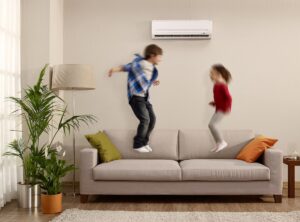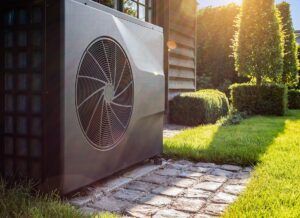Ductless mini split heat pump systems are simple, efficient, and flexible, particularly in comparison to traditional ducted climate control systems. Understanding how these systems work can help you select the right system to maximize these benefits.
Differences Between Mini Split Heat Pump Systems and Traditional Ducted Systems

Ductless mini split heat pump systems have two main components: (1) a compressor located outside the home, and (2) one or more air handler units located in individual rooms inside the home.
The indoor air handler units contain evaporator coils that are cooled with refrigerant. When the system is cooling, warm air from the room blows over and is absorbed by the coils, and the refrigerant transfers that inside heat to the outdoor unit. When the system is heating, the process is reversed. The refrigerant changes direction and absorbs heat from the outside air and transfers it to the interior.
Thus, instead of a central unit transporting warm and cool air through long lengths of ductwork, a mini-split system places small blower (or air handler) units in each room, which pull in warm air and send it back out as cold air, or vice versa. (The “split” in the description refers to the fact that the condenser and the blower aspects of the unit are separately located, or split, from one another.)
Benefits of Ductless Mini Split Heat Pump Systems vs. Traditional Ducted Systems
While there are certain homes for which traditional ducted air handling systems make sense, in many cases ductless mini split heat pump systems will offer significant advantages, including:
- Efficiency: because mini-splits systems have no ducts, the energy loss that inevitably comes with the use of central forced-air-through-ductwork systems can be entirely avoided. According to the DOE, these losses can make up 30% of energy consumption for a typical central air system.
- Ease of Installation: Ductless mini-split systems are also often easier to install than other types of air conditioning systems. The hook-up between the outdoor and indoor units generally requires only a three-inch hole through a wall for the conduit. In comparison, creation of new ductwork is an expensive and highly disruptive proposition.
- Flexibility in Operation: In a ductless mini split system, each indoor unit can be controlled independently of the others, meaning that you can adjust the temperature, airflow and other setting of one air handler (i.e., one zone of your house) without impacting the others. This also allows you to only condition space while it is occupied, saving additional money and energy.
- Heating and cooling: Ductless mini split heat pumps can provide both heating and cooling, giving you a single, highly-efficient system that keeps you cool in the summer and warm through the winter.
Measuring Efficiency of Ductless Mini Split Heat Pump Systems

Measuring and understanding the efficiency of your heat pump system is crucial both to understand the capabilities of your system and to ensure that your system qualifies for various federal and state rebates and incentives. Two major measurements are:
- Seasonal Energy Efficiency Rating (SEER). SEER is a measure of how much energy an air conditioning unit will use during one year. It measures the cooling output (measured in British Thermal Units (BTUs)) during a typical cooling-season divided by the total electric energy consumed (measured in watt-hours) during the same period. The higher a unit’s SEER rating the more efficient it is.
- Heating Seasonal Performance Factor (HSPF). HSPF is a measure of a heat pump’s efficiency during the heating season. HSPF ratings are calculated by dividing the total heating output during the heating season (measured in BTUs) by the total watt-hours of energy consumed during that time (measured in kWh). The higher the unit’s HSPF rating the more energy efficient it is.
In other words, SEER ratings measure the efficiency of cooling systems and HSPF ratings measure the efficiency of heating systems. Because they provide both heating and cooling, heat pump systems are assigned both SEER and HSPF ratings.
In 2023 the Federal Government has issued updated version of these standard, referred to as SEER2 and HSPF2 respectively.
- Minimum SEER2 efficiency: The DOE has established 14.3 SEER2 as the minimum allowable cooling efficiency for residential, air-source, split-system heat pumps, as of January 1, 2023. Models rated at or above 17 SEER2 are typically considered highly efficient.
- Minimum HSPF2 efficiency. The DOE has established 7.5 HSPF2 as the minimum allowable heating efficiency for residential, air-source, split-system heat pumps, as of January 1, 2023.
Sizing a Ductless Mini Split Heat Pump System
It is crucial to select the right size mini split system for the area you are seeking to heat and cool. Not only does the size of the system impact the cost (bigger system = more cost) but sizing the system appropriately is also key to achieving all the benefits that come with ductless heating and cooling.
For example, if the system is undersized, it may struggle to condition the room to the programmed temperature, causing it to run almost constantly, which in turn can drive up costs and result in the system wearing out sooner than it should. Conversely, an oversized system may “short cycle,” or continuously turn itself on and off as it quickly reaches the target temperature. This can also cause increased costs and can have other deleterious effects such as failure to control humidity due to very short run times.
The best way to avoid these issues is to have an expert determine what size ductless mini split heat pump system is right for you. You can reach a ballpark idea of the right size ductless mini split system for you, because it is a function of the square footage of the space you are seeking to condition.
Mini split ductless heat pump systems are rated in terms of their capability to deliver a specified amount of British Thermal Units per hour (BTU/hr.).
To get a ballpark size of the interior units:
- Calculate the square footage of the size of the room you are seeking to condition
- Multiply the square footage by 25 and express the total in British Thermal Units per hour (BTU/hr.)
For example, a 15 x 15square room is 225 square feet, multiplied by 25 BTU/hour equals 5,625 BTU/h. (A round room requires measurement of the radius, squared, multiplied by pi – and they said we would never use high school geometry!)
This simple calculation provides only a first-line estimate, and does not replace a complete analysis. An expert installer will conduct a complete load calculation that will consider many additional factors such as ceiling height, presence and quality of insulation (poor insulation requires a larger system to account for loss), climate, window amount and quality, sun exposure, room layout and airflow, and other individualized factors.
As noted above, the mini split heat pump system is comprised of an outdoor unit and one or more indoor unit. The size of the outdoor unit should be sized for the total space you are seeking to condition (i.e., all the rooms or the entire home), whereas each indoor unit should be sized for the space that it is responsible for heating and cooling.
Other considerations affecting the design of a Mini Split Heat Pump System
- System design: Beyond just sizing the unit, a professional installation includes a design plan for the full ductless mini split heat pump system, including the number, type and best placement of the indoor air handling units, the best placement of the outdoor unit, and the route and best manner of running the conduit, tubing, and cabling between the indoor and outdoor units.
- Type of air handling units: Air handling units are available in a variety of options, including wall mounted, floor and ceiling mounted, and ceiling cassettes, which can sit recessed in some types of ceilings. A professional installation includes detailed consideration of the type of air handling units best-suited for a given system.
- Availability of incentives and rebates: A professional installer can help ensure that the ductless mini split heat pump system you select is eligible for the full suite of state and federal rebates and incentives. This can include ensuring that the system achieves the required SEER2 and HSPF2 ratings, discussed above, and a check against lists of eligible products maintained by state entities such as NH Saves and Efficiency Maine.